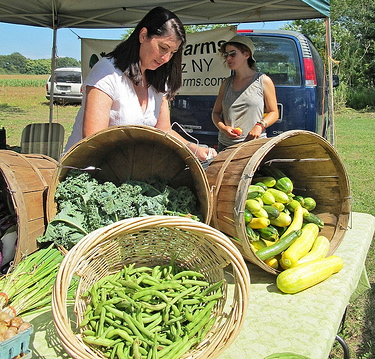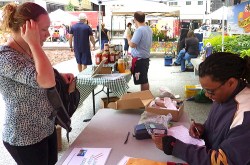When it comes to giving more people access to fresh, healthy food, the United States Department of Agriculture (USDA) has turned a great deal of its focus in recent years toward farmers markets. And, more specifically, opening farmers markets up to Electronic Benefit Transfer (EBT) or “food stamp” users.
In fact, the agency reports, spending at farmers markets under the Supplemental Nutrition Assistance Program (SNAP) has already jumped by 400 percent since 2008 — and that’s with less than a quarter of the country’s 7,000 markets participating in the program.
“That’s a huge transformation in the farmers market world, in terms of people being able to feel like they’re invited to the party,” USDA deputy secretary Kathleen Merrigan said in a phone interview.
Expanding SNAP at farmers markets is part of the agency’s broader approach to increasing healthy food access for low-income communities that lack adequate grocery stores and public transportation — areas known (if sometimes controversially so) as food deserts. So when this year’s budget talks came around, the USDA requested $4 million to expand the effort. (Cost is a major reason why more farmers markets don’t already participate: SNAP benefits are redeemed through the EBT system, which relies on wireless technology, and that doesn’t come free.)
Today, the USDA announced it will begin to allocate funds to states with the greatest numbers of EBT-less farmers markets. The states will then decide how best to spend the money for each market: Some may purchase just the wireless equipment, others may buy the equipment and hire someone to manage it, or make other investments that will help manage the program effectively.
Because of that variation, it’s not clear how many more markets will now start redeeming SNAP benefits, but Merrigan estimates that the machines could reach an additional 4,000 farmers markets.
She hopes those markets will help break some of the stereotypes that have developed around eating and cooking with fresh, local fruits and vegetables.
“Twenty years ago or more, people thought this was something for the elite. Clearly that’s not the case, and the expansion of farmers markets with EBT has really proven that,” Merrigan added. And she’s optimistic that more time spent at these markets can lead to other healthy lifestyle shifts as well. “Hopefully some of those people are going to farmers markets on their bikes and walking,” she said.
That said, use of SNAP at farmers markets isn’t going to be the solution that solves all the country’s food problems, and Merrigan recognizes that.
“There’s no silver bullet,” she added.
And because someone will be able to buy local kale or fiddlehead ferns using EBT doesn’t mean they’re going to have the time or experience to cook them. For that reason, Merrigan emphasizes SNAP as a piece of a broader, multi-pronged approach, which includes: “getting access to the food, figuring out what to do with it, and then understanding why it’s important.”
But while this effort by the USDA won’t produce miracles, it will likely give more SNAP users — many of whom do cook at home — quicker, easier access to fresh produce. And that’s no small part of the battle. As Merrigan said, “Getting people to those markets is inviting them into really healthy eating.”




